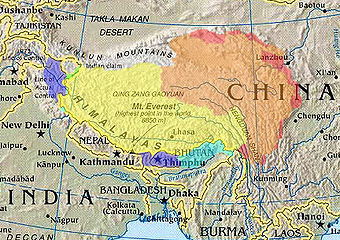Tibet: Monks Punished Over Protests
By RFA
More than 70 monks have been disrobed and others beaten at a Tibetan monastery and have had their religious classes and study groups canceled as punishment for actions challenging Chinese rule, according to Tibetan sources.
The crackdown at the Boeyag monastery in the Tibet Autonomous Region’s Menda township, Chamdo county, has been under way since two monks were detained in March for leading prayers for Tibetans who have burned themselves to death in protests, a resident of the area told RFA’s Tibetan service.
The whereabouts of Jamyang Yeshe—the monastery’s chant leader—and a monk named Drubgyu are still not known almost eight months after they were taken into custody, the source said, speaking on condition of anonymity.

“The two monks were accused of organizing prayers for self-immolators and for holding long-life prayers for the Dalai Lama,” the source said, speaking on condition of anonymity.
“They were also accused of ‘illegally’ teaching Buddhism to laypeople outside the monastery and of promoting the intensive study of the Tibetan language, which has become increasingly popular in the area,” the source said.
Harsh restrictions
Sources told RFA that Chinese authorities placed harsh restrictions on the Boeyag monastery beginning March 10, when monks were accused of “behaving badly” at a flag-raising conducted at the monastery by Chinese officials.
“The monks suffered severe beatings,” the source said.
More than 70 monks from the monastery have now been forcibly returned to lay status and forbidden to wear their robes, the source said, adding that religious classes and study groups have also been closed.
“Now, the abbots and other monks are not allowed outside the monastery grounds for more than three days at a time, which has caused great hardships for them,” he said.
In one case, Thoega Rinpoche, 64, a senior teacher at the monastery, was denied permission to leave to seek medical treatment after falling ill, and he died on Aug. 16, he added.
“Both the monastery and Tibetan households in the area are forced to display posters showing the Chinese flag and portraits of several generations of Chinese Communist leaders,” he said.
“Not having these in one’s possession is considered a violation of the law.”
Tibetan flag raised
Fifty-five Tibetans have burned themselves to death since February 2009 in protests challenging Chinese rule and calling for the return of the Dalai Lama, Tibet’s exiled spiritual leader, as Tibetans increasingly question Chinese policies which they say are discriminatory and have robbed them of their rights.
Most of the burnings have occurred in Tibetan-populated areas of the Chinese provinces of Sichuan, Qinghai, and Gansu, but five have been reported in the Tibetan Autonomous Region in spite of Chinese efforts to keep the protests from spreading.
Meanwhile, Chinese police in the Wonpo region of Dzachukha in Sichuan province’s Kardze prefecture on Monday detained five Tibetans suspected of raising the banned Tibetan national flag during a Sept. 7 protest at a local school, according to Tibetan reports.
A Chinese flag had first been pulled down, and leaflets calling for Tibetan freedom were scattered on the school’s grounds.
No arrests were made at the time, but officials vowed to investigate the incident, sources said.
The names of those picked up in the late-night raid and information on where they are being held are still unknown.
Reported by RFA’s Tibetan service. Translated by Dorjee Damdul. Written in English by Richard Finney.
